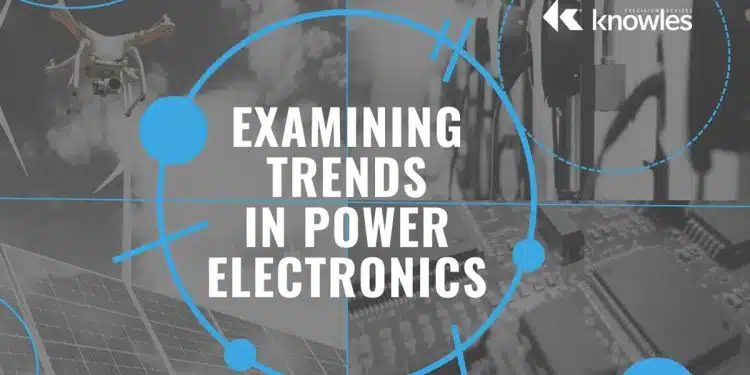This article based on Knowles Precision Devices blog that examine current trends in power electronics.
Power electronics is an industry segment with rapid innovation. At a high level, the trends driving power electronics innovation are largely centered around methods for providing more energy more efficiently while using smaller components. Below are four key power electronics trends to follow:
Trend 1: Increasing Investment in Renewable Energy Technologies
In 2023, the renewable energy market grew significantly, with capacity increasing by almost 50 percent to nearly 510 GWs. Since this growth was driven largely by new regulations and the work energy providers are doing to help achieve climate change goals, we expect to see significant growth in this sector in 2024 as well. As generation capacity grows, so does the demand for the components required, even down to the board level, to power and control the technologies required to support renewable energy generation, transmission, and storage.
But, as with any evolving industry segment, the demands on today’s components won’t be the same as what will be required down the road. Therefore, as this industry grows and innovates, the vast amount of vital power electronics used as the building blocks for these renewable energy technologies must experience innovation as well. This is where we come in.
At Knowles, we are constantly innovating on our components to keep up with the latest demands in the renewable energy market. We recently released a new low-loss ultra stable high capacitance multilayer ceramic capacitor (MLCC) for power electronics perfect for this segment. Additionally, these film capacitors are optimized for harsh outdoor environments, making them ideal for solar power converter and energy storage applications.
Trend 2: Continued Electric Vehicle Innovation
As part of ongoing EV innovations, EV engineers are constantly thinking about ways to convert power more efficiently to address consumer concerns such as range anxiety and charging times. As a result, there is a trend to focus on making EVs lighter and improving gravimetric density, which means every component used in a vehicle down to the board level must be heavily scrutinized when it comes to their size, weight, and power (SWaP). Knowles has a range of MLCCs that can be used as resonant capacitors in EV power electronics to help EV engineers achieve these goals.
Trend 3: Growing Demand for UAVs
In a variety of industries ranging from aerospace and defense to telecom, there is a growing trend to use unmanned aerial vehicles (UAVs), or drones, as an efficient, safe, and cost-effective solution for performing tasks that may be too difficult, dangerous, or time consuming for humans. As with any airborne device, SWaP is a critical consideration for UAVs and designers are constantly looking for ways to improve the volumetric density of the power electronics used in these devices.
Since every gram counts in a drone, the size and weight of even the smallest component must be heavily scrutinized. But, because of the mission-critical nature of many UAVs, reliability cannot go by the wayside. At Knowles, we are well-prepared to help you meet all of these demands with our high-performance capacitors that are smaller, lighter, and consume less power and are designed to power your UAV electronic systems reliably for their lifetime while operating at higher voltages and wider temperature ranges.
Trend 4: Improving Power Electronics Efficiency with Wide-Bandgap Semiconductors
As the power electronics systems used in a wide variety of applications require operations at higher voltages and wider temperature ranges, new circuit design trends are emerging to meet these demands. The latest trend we are seeing is for electrical engineers to shift from using conventional silicon-based (Si) semiconductors to using wide-bandgap semiconductors built with silicon carbide (SiC) or gallium nitride (GaN).
Electronic components built using these materials can switch faster, are more efficient, and have lower SWaP than traditional Si-based options. For example, SiC-based converters can handle voltages up to 10 times greater than converters using just Si while also offering lower losses. As this shift occurs, the “jobs” that need to be done by capacitors used in the power electronics systems are changing as well. For example, check out how you can use snubber circuits to both protect and increase the benefits of your SiC-based converters.






























